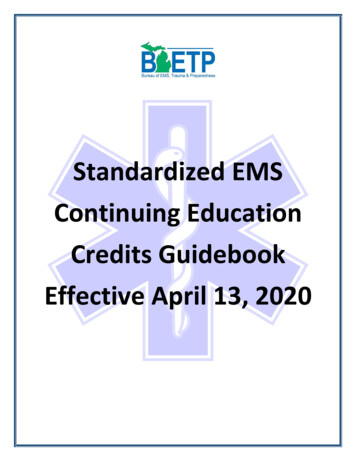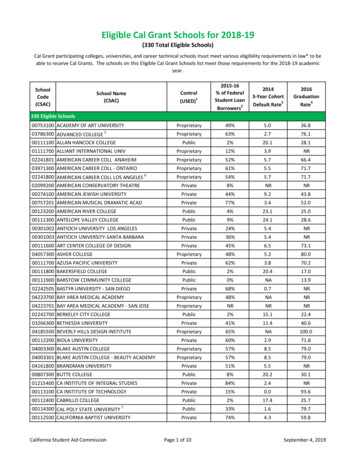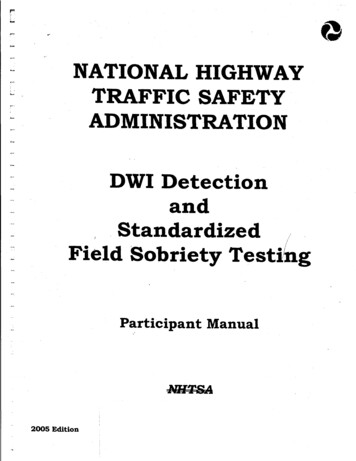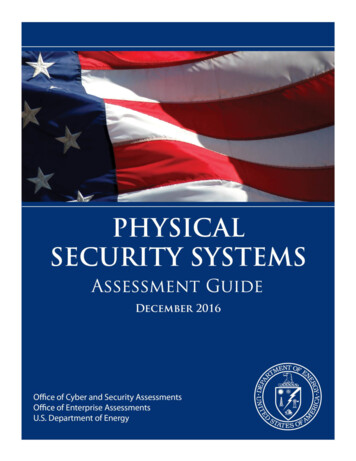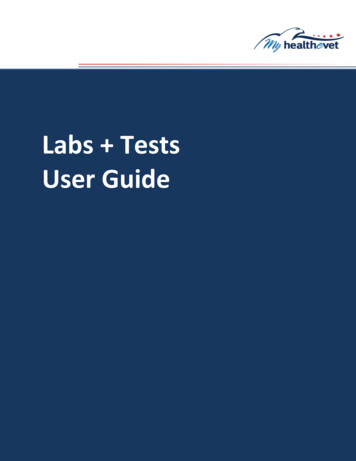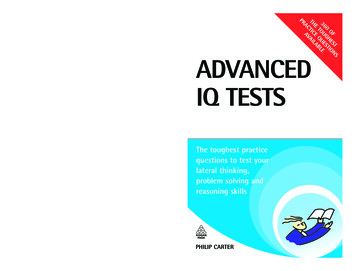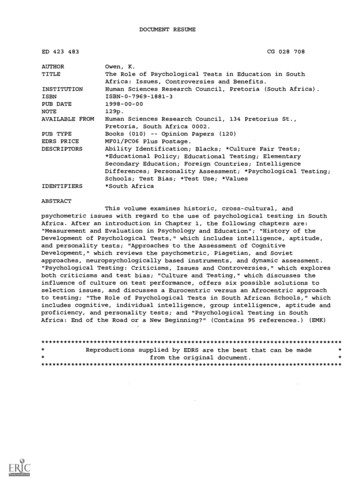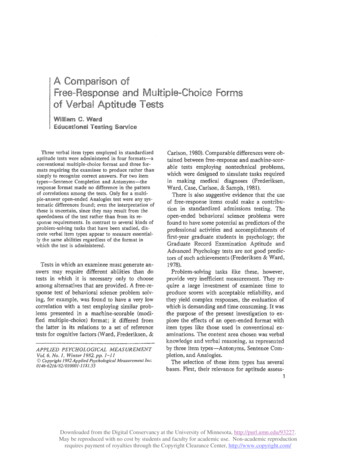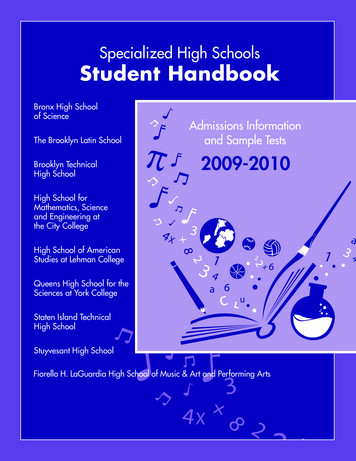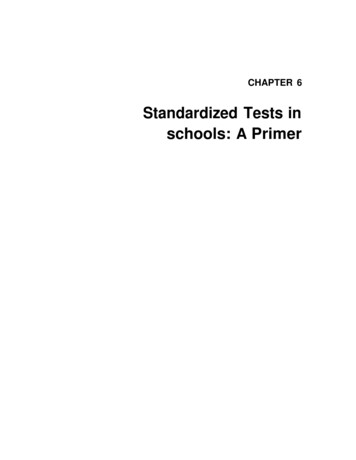
Transcription
CHAPTER 6Standardized Tests inschools: A Primer
ContentsHighlights . . . . . . . . . . . . . . . . . . . . . . . . . . . . . . . . . . . . . . . . . . . . . . . . . . . . . . . . . . . . . . . . . . . . . . 165How Do Schools Test? . . . . . . . . . . . . . . . . . . . . . . . . . . . . . . . . . . . . . . . . . . . . . . . . . . . . . . . . . . . 165Creating a Standardized Test: Concern for Consistency and Accuracy . . . . . . . . . . . . . . . . 171What is a Standardized Test? . . . . . . . . . . . . . . . . . . . . . . . . . . . . . . . . . . . . . . . . . . . . . . . . . . 173Reliability of Test Scores . . . . . . . . . . . . . . . . . . . . . . . . . . . . . . . . . . . . . . . . . . . . . . . . . . . . . . 175Validity Evidence for Tests . . . . . . . . . . . . . . . . . . . . . . . . . . . . . . . . . . . . . . . . . . . . . . . . . . . . .176How are Achievement Tests Used? . . . . . . . . . . . . . . . . . . . . . . . . . . . . . . . . . . . . . . . . . . . . . . . . 179Consumers of Achievement Tests . . . . . . . . . . . . . . . . . . . . . . . . . . . . . . . . . . . . . . . . . . . . . . . 181Test Misuse . . . . . . . . . . . . . . . . . . . . . . . . . . . . . . . . . . . . . . . . . . . . . . . . . . . . . . . . . . . . . . . . . . 184Changing Needs and Uses for Standardized Tests . . . . . . . . . . . . . . . . . . . . . . . . . . . . . . . . . . 185What Should the Yardstick Be? . . . . . . . . . . . . . . . . . . . . . . . . . . . . . . . . . . . . . . . . . . . . . . . . 186How Much is Enough? Setting Standards . . . . . . . . . . . . . . . . . . . . . . . . . . . . . . . . . . . . . . . . 187What Should the Tests Look Like? . . . . . . . . . . . . . . . . . . . . . . . . . . . . . . . . . . . . . . . . . . . . . 188Multiple Choice: A Renewable Technology? . . . . . . . . . . . . . . . . . . . . . . . . . . . . . . . . . . . . 191Redesigning Tests: Function Before Form . . . . . . . . . . . . . . . . . . . . . . . . . . . . . . . . . . . . . . . 194Conclusions . . . . . . . . . . . . . . . . . . . . . . . . . . . . . . . . . . . . . . . . . . . . . . . . . . . . . . . . . . . . . . . . . . . . 197BoxesBoxPage6-A. Achievement and Aptitude Tests: What is the Difference? . . . . . . . . . . . . . . . . . . . . . 1686-B. Types of Standardized Achievement Tests . . . . . . . . . . . . . . . . . . . . . . . . . . . . . . . . . . . . 1706-C. How a Standardized Norm-Referenced Achievement Test is Developed . . . . . . . . . 1726-D. Large-Scale Testing Programs: Constraints on the Design of Tests . . . . . . . . . . . . . . 1746-E. Test Score Reliability: How Accurate is the Estimate? . . . . . . . . . . . . . . . . . . . . . . . . . 1766-F. Helping the Student Understand Expectations: The Need for Clear Criteria . . . . . . . 1886-G. Setting and Maintaining Standards . . . . . . . . . . . . . . . . . . . . . . . . . . . . . . . . . . . . . . . . . . . . 190FiguresFigurePage6-1. Tests Used With Children . . . . . . . . . . . . . . . . . . . . . . . . . . . . . . . . . . . . . . . . . . . . . . . . . . . . .1666-2. Thorndike’s Scale for Measuring Handwriting . . . . . . . . . . . . . . . . . . . . . . . . . . . . . . . . . 1736-3. Testing Requirements: Three District Examples . . . . . . . . . . . . . . . . . . . . . . . . . . . . . . . 1836-4. Sample Multiple-Choice Items Designed To Measure Complex Thinking Skills . . 1936-5. Sample Multiple-Choice Item With Alternative Answers Representing CommonStudent Misconceptions . . . . . . . . . . . . . . . . . . . . . . . . . . . . . . . . . . . . . . . . . . . . . . . . . . . . . . . 194TablesTablePage6-1. Three Major Functions of Educational Tests . . . . . . . . . . . . . . . . . . . . . . . . . . . . . . . . . . . 1806-2. Consumers and Uses of Standardized Test Information . . . . . . . . . . . . . . . . . . . . . . . . . 1816-3. Functions of Tests: What Designs Are Needed? . . . . . . . . . . . . . . . . . . . . . . . . . . . . . . . . 195
CHAPTER 6Standardized Tests in Schools: A PrimerHighlightsA test is an objective and standardized method for estimating behavior, based on a sample of thatbehavior. A standardized testis one that uses uniform procedures for administration and scoring in orderto assure that results from different people are comparable. Any kind of test—from multiple choice toessays to oral examinations--can be standardized if uniform scoring and administration are used.Achievement tests are the most widely used tests in schools. Achievement tests are designed toassess what a student knows and can do as a result of schooling. Among standardized achievement tests,multiple-choice formats predominate because they are efficient, easily administered, broad in theircoverage, and can be machine scored.Advances in test design and technology have made American standardized achievement testsremarkably sophisticated, reliable, and precise. However, misuse of tests and misconceptions about whattest scores mean are common.Tests are often used for purposes for which they have not been designed. Tests must be designedand validated for a specific function and use of a test should be limited to only those functions. Once testsare in the public domain, misuse or misinterpretation of test results is not easy to control or change.Because test scores are estimates and can vary for reasons that have nothing to do with studentachievement, the results of a single test should never be used as the sole criterion for making importantdecisions about individuals. A test must meet high standards of reliability and validity before it is usedfor any “high-stakes” decisions.The kind of information policymakers and school authorities need to monitor school systems is verydifferent from the kind teachers need to guide instruction. Relatively few standardized tests fulfill theclassroom needs of teachers.Existing standardized norm-referenced tests primarily test basic skills. This is because they are‘‘generic” tests designed to be used in schools throughout the Nation, and basic skills are most commonto all curricula.Current disaffection with existing standardized achievement tests rests largely on three features ofthese tests: 1) most are norm-referenced and thus compare students to one another, 2) most are multiplechoice, and 3) their content does not adequately represent local curricula, especially thinking andreasoning skills. This disaffection is driving efforts among educators and test developers to broaden theformat of standardized tests. They seek to design tests more closely matched to local curricula, and todesign tests that best serve the various functions of educational testing.Changing the format of tests will not, by itself, ensure that tests are better measures of desired goalsnor will it eliminate problems of bias, reliability, and validity. In part because of these technical andadministrative concerns, test developers are exploring ways to improve multiple-choice formats tomeasure complex thinking skills better. As new tests are designed, new safeguards will be needed toensure they are not misused.How Do Schools Test?Nearly every type of available test designed foruse with children is used in schools. Tests ofpersonality, intelligence, aptitude, speech, sensoryacuity, and perceptual motor skill, all of which haveapplications in nonschool settings as well, are usedby trained personnel such as guidance counselors,speech-language specialists, and school psychologists. Certain tests, however, have been designedspecifically for use in educational settings. These-165-
166 Testing in American Schools: Asking the Right QuestionsFigure 6-l—Tests Used-[‘With Children,– – –-.Other tests ‘1Intelligence/aptitudePersonal it yDevelopmental scales-1-------for infantsSpeech/oral languageMotor proficiencyMedicalSensory acuity(e. g., vision, hearing)Driver’s license examAuditions (performing arts)Athletic try-outs andcompetitions11/Test and i tern formatsMultiple-choice. True-false 1Most existingstandardizedachievementc C o n s t r u c t e d - r e s p o n s e ] tests EssaysPerformance Oral exams assessment Exhibitions Experiments Portfolios&,SOURCE: Office of Technology Assessment, 1992; adapted from F.L. Finch, “Toward a Definition for EducationalPerformance Assessment,” paper presented at the ERIC/PDK Symposium, August 1990.tests, commonly referred to as achievement tests, aredesigned to assess student learningin school subjectareas. They are also the most frequently used tests inelementary and secondary school settings; with fewexceptions all students take achievement tests atmultiple points in their educational careers. Educational achievement tests are the primary focus of thisreport.Figure 6-1 shows the distinction between educational achievement tests and the other kinds of tests.Achievement tests are designed to assess what astudent knows and can do in a specific subject areaas a result of instruction or schooling. Achievementtest results are designed to indicate a student’sdegree of success in past learning activity. Achievement tests are sometimes contrasted with aptitudetests, which are designed to predict what a personcan be expected to accomplish with training (see box6-A).Achievement tests include a wide range of typesof tests, from those designed by individual teachersto those designed by commercial test publishingcompanies. Examples of the kinds of tests teachersdesign and use include a weekly spelling test, a finalessay examination in history, or a laboratory examination in biology. At the other end of the achievement test spectrum are tests designed outside theschool system itself and administered only once ortwice a year; examples of this include the familiarmultiple-choice, paper-and-pencil tests that mightcover reading, language arts, mathematics, andsocial studies (see box 6-B).The first important distinction when talking aboutachievement tests is between standardized andnonstandardized tests (see figure 6-1 again).l Astandardized test uses uniform procedures for administering and scoring. This assures that scoresobtained by different people are comparable to oneanother. Because of this, tests that are not standardized have limited practical usefulness outside of theclassroom. Most teacher-developed tests or "back-ofthe-book’ tests found in textbooks would be consid-IFrefick L. Finch The Riverside Publitig CO., “Toward a Definition for Educational Perfo rmance Assessmen ” paper presented at theERIC/PDK Symposium, 1990.
Chapter 6—Standardized Tests in Schools: A Primer 167Photo credit: Dennis GaliowayStandardized achievement tests are often administered to many students at the same sitting. Standardization means thattests are administered and scored under the same conditions for all students and ensures that results arecomparable across classrooms and schools.297-933 0 - 92 -- 12 : QL 3
168 . Testing in American Schools: Asking the Right QuestionsBox 6-A—Achievement and Aptitude Tests: What is the Difference?Attempts to measure learning as a result of schooling (achievement) and attempts to measure aptitude(including intelligence) each have different, yet intertwined, histories (see ch. 4). Intelligence testing, with its strongpsychometric and scientific emphasis, has influenced the design of achievement tests m this country. Achievementtests are generally distinguished from aptitude tests in the degree to which they are explicitly tied to a course ofschooling. In the absence of common national educational goals, the need for achievement tests that can be takenby any student has resulted in tests more remote from specific curricula than tests developed close to the classroom.The degree of difference can be subtle and the test’s title is not always a reliable guide.A test producer’s claims for anl achievement test or an aptitude test do not mean that it will function as such in allcircumstances with all pupils.There clearly is overlap between a pupil’s measured ability and achievement, and perhaps the final answer to thequestion of whether any test assesses a pupil’s achievement or a more general underlying trait such as verbal abilityrests with the local user, who knows the student and the curriculum he or she has followed. 2The farther removed a test is from the specific educational curricula that has been delivered to the test taker, the morethat test is likely to resemble a measure of aptitude instead of achievement for that student.Whenever tests are going to be used for policy decisions about the effectiveness of education, it is importantto assure that those tests are measuring achievement, not ability; inferences about school effectiveness must bedirectly tied to what the school actually delivers in the classroom--not to what children already bring to theclassroom. Accordingly, tests designated for accountability should be shown to be sensitive to the effects ofschool-related instruction.3To understand better the distinctions currently made between achievement and aptitude tests, it is helpful toturn to one of the “pillars of assessment development,”4 Anne Anastasi:Surpassing all other types of standardized tests in sheer number, achievement tests are designed to measure theeffects of a specific program of instruction or training. It has been customary to contrast achievement tests with1 Gardner, “Some Aspeets of the Use and Misuse of Standardized Aptitude and Achievement ‘Rsts,” AbiJity T ting: Uses,Consequences, and Controversies, part2, Alexandra. Wigdor and Wendell R. Garner (eds.) (Washington, DC: National &X&lypreSS, 1982),p. 325.zp er w. “RevieW Of IOWa ‘I&W Of Basic skills, Forms 7 and 8,”VO1. 1, hUM%V. Mitchell, Jr. (cd.) (Linco NE: The University of Nebraslm Press, 1985), p. 720.3N0 aebievernent tcs thou will mmnm onZy school-related learning. For any chilq learning takes place daiIy and as a result of allhis or her cumulative experiences. “No test reveals how or why the individual rcaehcd tit level.” Anne Anastasipublishing Co, 1988), p. 413.6rol Schneider Lie “Historical Perspectives,”ered nonstandardized. Although these tests may beuseful to the individual teacher, scores obtain&l bystudents on these tests would not be comparable-across classrooms, schools, or different points intime-because the administration and scoring arenot standardized.Thus, contrary to popular understanding, “standardized’ does not mean norm-referenced nor does itmean multiple choice. As the tree diagram in figure6-1 illustrates, standardized tests can take manydifferent forms. All achievement tests intended forwidespread use in decisions comparing children,schools, and districts should be standardized. Lackof standardization severely limits the inferences andconclusions that can be made on the basis of testresults. A test can be more or less standardized (thereis no absolute criterion or yardstick to denote whena test has ‘‘achieved’ standardization); as a result,teacher-developed tests can incorporate features ofstandardization that will permit inferences to bemade with more confidence.Most existing standardized tests can be dividedinto two primary types based on the reference pointfor score comparison: norm-referenced and criterionreferenced.Norm-referenced tests help compare one student’s performance with the performances of a largegroup of students. Norm-referenced tests are de-
Chapter 6-Standardized Tests in Schools: A Primer 169aptitude tests, the latter including general intelligence tests, multiple aptitude batteries, and special aptitude tests.From one point of view, the difference between achievement and aptitude testing is a difference in the degree ofuniformity of relevant antecedent experience. Thus achievement tests measure the effects of relatively standardizedsets of experiences, such as a course in elementary French, trigonometry, or computer programming. In contrast,aptitude test performance reflects the cumulative influence of a multiplicity of experiences in daily living. We mightsay that aptitude tests measure the effects of learning under relatively uncontrolled and unknown conditions, whileachievement tests measure the effects of learning that occurred under partially known and controlled conditions.A second distinction between aptitude and achievement tests pertains to their respective uses. Aptitude testsserve to predict subsequent performance. They are employed to estimate the extent to which the individual will profitfrom a specified course of training, or to forecast the quality of his or her achievement in a new situation. Achievementtests, on the other hand, generally represent a terminal evaluation of the individual’sstatus on the completion of5training. The emphasis on such tests is on what the individual can do at the time.Although in the early days of psychological testing aptitude tests were thought to measure ‘innate capacity”(unrelated to schooling, experience, or background), while achievement tests were thought to measure learning, thisis now considered a misconception.6 Any test score will reflect a combination of school learning, prior experience,ability, individual characteristics (e.g., motivation), and opportunities to learn outside of school. Aptitude andachievement tests differ primarily in the extent to which the test content is directly affected by school experiences.In the 1970s, aptitude tests, particularly IQ tests, came under increasing scrutiny and criticism. A highlypolitical debate, set off by Arthur Jensen’s controversial analysis of the heritability of racial differences inintelligence, thrust IQ tests into the limelight. Similarly, the late 1960s and early 1970s saw several significant courtchallenges to the use of IQ tests in ability tracking. Probably because of these controversies, as well as increasedunderstanding of the limitations of intelligence tests, many large school systems have moved away from usingaptitude tests as components of their basic testing programs.7 These tests are still widely marketed, however, andtheir use in combination with achievement tests is often promoted.Achievement and aptitude tests differ, but the distinctions between the two in terms of design and use are oftenblurred. For policy purposes, the essential point is this: even though a test maybe defined as an achievement test,the more it moves away from items tied to specific curriculum content and toward items that assess broader conceptsand skills, the more the test will function as an aptitude test. Should a national test be constructed in the absenceof national standards or curriculum, it is therefore likely to be essentially an aptitude test. Such a test will noteffectively reflect the results of schooling.5 i,op. cit., fOOtXIOk3, PP. 41 1 14.61bid.7c. Dimengo, Basic Testing progm Used in Major School Systems Throughow the United States in the School Year 1977-78 (Akron,OH: Atcmn Public Schools Division of Personnel and . .stratio% 1978).signed to make fine distinctions between students’performances and accurately pinpoint where a student stands in relation to a large group of students.2These tests are designed to rank students along acontinuum.large numbers of school children representative ofthe Nation’s student population (see box 6-C). Thescore of each student who takes that test can becompared to the performance of other children in thestandardization sample. Typically a single NRT isused by many schools and districts throughout the3country.Because of the complexities involved in obtainingnationally representative norms, norm-referencedCriterion-referenced tests (CRTs) are focused ontests (NRTs) are usually developed by commercialtest-publishing companies who administer the test to “. . . what test takers can do and what they know, not%mvrence Rudner, Jane Close Conoley, and Barbara S. Plake (eds.), Understanding Achievement Tests (Washington DC: ERIC Clearinghouse onlksts, Measurement, and EvaluatiorL 1989), p. 10.sMmy Pubhshem Offm s ct-level nom as ell. Seved publishers now c atc CUStOrn-&VelO@ norm-referenced tests that are b-d On Iocidcurricular objectives, yet come with national norms. These norms, however, are only valid under certain circumstances. See ibid.
170 Testing in American Schools: Asking the Right QuestionsBox 6-B—Types of Standardized Achievement TestsCurrently available standardized achievement tests are likely to be one of four types. l The best known and mostwidely used type is the broad general survey achievement battery. These tests are used across the entire age rangefrom kindergarten through adult, but are most widely used in elementary school. They provide scores in the majoracademic areas such as reading, language, mathematics, and sometimes science and social studies. They are usuallycommercially developed, norm-referenced, multiple-choice tests. Examples include the Comprehensive Test ofBasic Skills, the Metropolitan Achievement Test, and the Iowa Tests of Basic Skills (ITBS). In addition, many testpublishers now offer essay tests of writing that can accompany a survey achievement test.In the 1989-90 school year, commercially published, off-the-shelf, achievement battery tests were a mandatedfeature of testing programs in about two-thirds of the States and the District of Columbia (see figure 6-B1). Fiveof those States required districts to select a commercial achievement test from a list of approved tests, while 27specified a particular test to be administered. In addition, many districts require a norm-referenced test (NRT), evenif the State does not. A survey of all districts in Pennsylvania, which does not mandate use of an NRT, found that91 percent of the districts used a commercial off-the-shelf NRT2The second type of test is the test of minimum competency in basic skills. These tests are usuallycriterion-referenced and are used for certifying attainment and/or awarding a high school diploma. They are mostoften used in secondary school and are usually developed by the State or district.3Far less frequently available as commercially published, standardized tests, the third category includesachievement tests in separate content areas. The best known examples of these are the Advanced Placementexaminations administered by the College Board, used to test mastery of specific subjects such as history or biologyat the end of high school for the purpose of obtaining college credit.The final type of achievement test is the diagnostic battery. These tests differ from the survey achievementbattery primarily in their specificity and depth; diagnostic tests have a more narrowly defined focus and concentrateon specific content knowledge and skills. They are generally designed to describe an individual’s strengths andweaknesses within a subject matter area and to suggest reasons for difficulties. Most published diagnostic tests covereither reading or mathematics. Many of the diagnostic achievement tests need to be individually administered bya trained examiner and are used in special education screening and diagnosis.four S of achievement tests is drawn from he AnastasiPublishing Co., 1988).2ROSSs. Blust W-MI R,ictid L. Kohr, Pennsylvania Department of EdueatioIL “PennsylvaniaSchool District dng Mop,” cDo-nt ED 269 44)9, TM 840-300, January 1984.3See ch. 2 for a discussion of USeS Of minimum Competency tests.how they compare to others. ’ CRTs usually reporthow a student is doing relative to specified educational goals or objectives. For example, a CRT scoremight describe which arithmetic operations a student can perform or the level of reading difficulty heor she can comprehend. Some of the earliestcriterion-referenced scales were attempts to judge astudent’s mastery of school-related skills such aspenmanship. Figure 6-2 illustrates one such scale,developed in 1910 by E.L. Thorndike to measurehandwriting. The figure shows some of the samplespecimens against which a student’s handwritingcould be judged and scored.Most certification examinations are criterionreferenced. The skills one needs to know to becertified as a pilot, for example, are clearly spelledout and criteria by which mastery is achieved aredescribed. Aspiring pilots then know which skills towork on. Eventually a pilot will be certified to fly notbecause she or he can perform these skills better thanmost classmates, but because knowledge and mastery of all important skills have been demonstrated.A- i, f’ chologicaz Testing (New Yorlq NY: MacMillan Publishing CO., 1988), p. 102. The term ‘ ‘crittion-referenced test’ k kmused here in its broadest sense and includes other terms such as content-, domain-, and objeetive-referenced tests.
Chapter 6—Standardized Tests in Schools: A Primer 171Figure 6-B1--State Requirements: Commercial Norm-ReferencedAchievement Tests, 1990 .,‘ NXSSStates that require districts toN R T s f r o m a p p r o v e d l i s t , n -5 .selectoff-the-shelfH State testing programs that do not require,1off-the-shelf NRTs, n 14.1 No State mandated testing program, n 4.NOTE: Kentucky and Arizona are currently changing their norm-referenced test (NRT) requirements (see ch. 7).Although Iowa has no State testing requirements, 95 pereent of its districts administer a commercial NRT.SOURCE: Office of Technology Assessment, 1992.Such tests will usually have designated “cutoff”scores or proficiency levels above which a studentmust score to pass the test.AAnother component of a standardized achievement test that warrants careful scrutiny is the formatof the test, the kind of items or tasks used todemonstrate student skills and knowledge. The finallevel in figure 6-1 depicts the range of testingformats. Almost all group-administered standardized achievement tests-are now made up of multiplechoice items5 (see box 6-D). Currently, educatorsand test developers are examining ways to use abroader range of formats in standardized achieve-ment tests. Most of these tasks, which range fromessays to portfolios to oral examinations, are labelled ‘performance assessment’ and are describedin the next chapter.Creating a Standardized Test:Concern for Consistency,and AccuracyThe construction of a good test is an attempt tomake a set of systematic observations in an accurateand equitable manner. In the time period sinceBinet’s pioneering efforts in the empirical design of5A um r of ommcially develo d achievement tes have added optional direct sample writing taSk. .
172 Testing in American Schools: Asking the Right QuestionsBox 6-C—How a Standardized Norm-Referenced Achievement Test is DevelopedlStep l-Specify general purpose of the testStep 2-Develop test specifications or blueprint Identify the content that the test will cover: for achievement tests this means specifying both the subjectmatter and the behavioral objectives. Conduct a curriculum analysis by reviewing current texts, curricular guidelines, and research and byconsulting experts in the subject areas and skills selected. Through this process a consensus definition ofimportant content and skills is established, ensuring that the content is valid.Step 3-Write items Often done by teams of professional item writers and subject matter experts. Many more items are written than will appear on the test. Items are reviewed for racial, ethnic, and sex bias by outside teams of professionals.Step 4-Pretest items. Preliminary versions of the items are tried out on large, representative samples of children. These samplesmust include children of all ages, geographic regions, ethnic groups, and so forth with whom the test willeventually be used.Step 5-Analyze items Statistical information collected for each item includes measures of item difficulty, item discrimination,agedifferences in easiness, and analysis of incorrect responses.Step 6-Locate standardization sample and conduct testing To obtain a nationally representative sample, publishers select students according to a number of relevantcharacteristics, including those for individual pupils (e.g., age and sex), school systems (e.g., public,parochial, or private) and communities (e.g., geographical regions or urban-rural-suburban). Most publishers administer two forms of a test at two different times of the year (fall and spring) duringStandardization.Step 7—Analyze standardization data, produce norms, analyze reliability and validity evidence Alternate forms are statistically equated to one another. Special norms (e.g., for urban or rural schools) are often prepared as well.Step 8--Publish test and test manuals Score reporting materials and guidelines are designed.l pt from ADthOq J. Ni&o, E&cationalYork N?’: I-Mcourt Brace Jownmkh,1983), pp. 468-476.tests, 6 considerable research effort has been ex-pended to develop theories of measurement andstatistical procedures for test construction. Thescience of test design, called psychometrics, hascontributed important principles of test design anduse. However, a test can be designed by anyone witha theory or a view to promote--witness the largenumber of ‘‘tests” of personality type, social IQ,attitude preference, health habits, and so forth thatappear in popular magazines. Few mechanismscurrently exist for monitoring the quality, accuracy,or credibility of tests. (See ch. 2 for further discussion of the issues of standards for tests, mechanisms‘%ee ch. 4.for monitoring test use, and protections for testtakers.)How good is a test? Does it do the things itpromises? What inferences and conclusions can bedrawn from the scores? Does the test really work?These are difficult questions to answer and shouldnot be determined by impressions, judgment, orappearances. Empirical information about the performance of large numbers of students on any giventest is needed to evaluate its effectiveness andmerits. This section addresses the principal methodsused to evaluate the technical quality of tests. It
Chapter 6-Standardized Tests in Schools: A Primer 173Sample of BehaviorFigure 6-2—Thorndike’s Scale for MeasuringHandwritingNo
tests are generally distinguished from aptitude tests in the degree to which they are explicitly tied to a course of schooling. In the absence of common national educational goals, the need for achievement tests that can be taken by any student has resulted in tests more remote from specific curricula than
